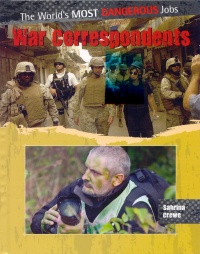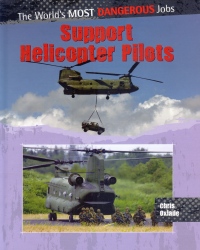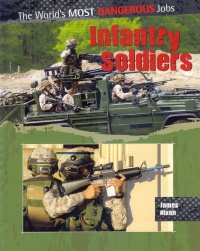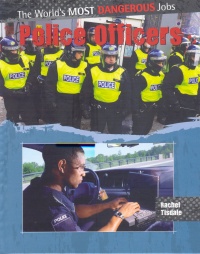| ________________
CM . . .
. Volume XIX Number 12. . . .November 23, 2012.
excerpt:
Unlike the jobs detailed in the first six volumes of this series, all of these entail the likely possibility of being shot at. Danger is rather obviously at the centre of them all. Luckily, all of them do have some less war like, if no less stressful, components: infantry soldiers are highly involved in peace keeping missions after direct combat has ended; police officers do community services and rescue work; even support helicopter pilots fly into areas in which natural disasters have occurred, ferrying essential supplies before roads and rail lines can be repaired to provide access to remote areas. Most of their work, however, means shooting and being shot at, and that adds up to danger in my books! As I said in my review of the earlier books of the series, the volumes are similar in many respects. Each has 32 coloured pages, with some type in black and some in white on variously coloured backgrounds. However, I was pleased to see that the specific criticism (that it was difficult to read) I made then of white print on a beige background has not been used in these volumes, although some of the other combinations (distressed black type on a mottled beige background with white spots) are almost as bad. Wisely, however, text is not superimposed onto pictures, eliminating possible distractions for less able readers. All volumes contain an index, a glossary with definitions of words which have appeared in bold face type in the book. Each also has a page headed "It's a fact!" containing "sound bites", as it were, of extra information that doesn't fit into the format of the previous pages. There are several pages in each volume devoted to direct quotations attributed to workers in the particular field under review, and, although I suspect that there has been liberal editing and simplification of actual words used, these add poignancy and immediacy to the books. An emphasis on the training required for these jobs is a useful point to make to young people who might otherwise feel that they could just walk into the job and start doing fun things like shooting, be it with guns or cameras. War correspondents are journalists who need background knowledge (i.e., frequently a degree in some field other than journalism) and the ability to write and talk about what they are seeing. Helicopter pilots need first to learn how to fly fixed wing planes since they are 'easier'(!) to manage than rotor driven machines. Police officers must be trained to do their jobs with a minimum of violence. These are not easy jobs, and they carry great responsibilities with them. I am afraid I don't remember, and can't check, whether the earlier books emphasized that women as well as men do all these jobs, but it is definitely a feature of these four volumes. Even combat zone postings are now open to women soldiers in the U.S., Canada, and Australia, although not those from the U.K. and New Zealand. The point of inclusion is made fairly subtly, mostly by including pictures of women in active roles in all of the books, and by using quotations attributed to female participants. These are not jobs I would want to encourage my daughter, if I had one, to undertake, but it is good to have it recognized that it is possible and that women can be good at them. The text is easy to read, but not so simple that it will not provide a challenge for students in the earlier grades, and the pictures and text support each other very well. The books provide a well balanced and reasonable description of dangerous, difficult jobs and the people who work at them, without attempting to glorify war and killing. Students should not get a totally wrong impression from reading them which is the best that one could hope for! Recommended. Mary Thomas worked for years in elementary school libraries in Winnipeg, MB, and while she deplored the fact that all boys seemed to fixate on guns and violence at some stage in their development, she was pleased to note that they mostly outgrew this.
To comment
on this title or this review, send mail to cm@umanitoba.ca.
Copyright © the Manitoba Library Association. Reproduction for personal
use is permitted only if this copyright notice is maintained. Any
other reproduction is prohibited without permission.
NEXT REVIEW |
TABLE OF CONTENTS FOR THIS ISSUE
-November 23, 2012.
AUTHORS |
TITLES |
MEDIA REVIEWS |
PROFILES |
BACK ISSUES |
SEARCH |
CMARCHIVE |
HOME |



